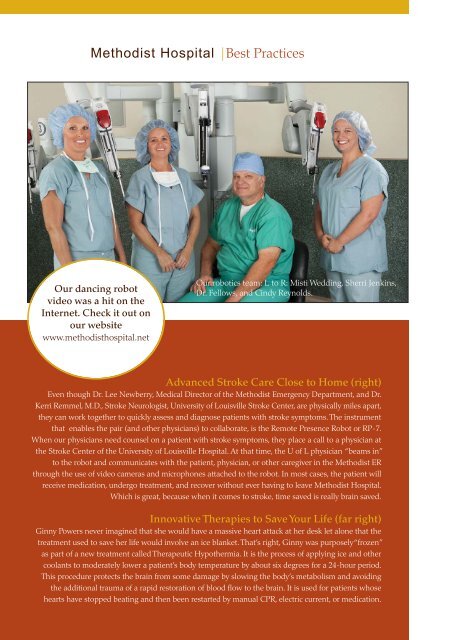You also want an ePaper? Increase the reach of your titles
YUMPU automatically turns print PDFs into web optimized ePapers that Google loves.
<strong>Methodist</strong> <strong>Hospital</strong> |Best Practices<br />
Our dancing robot<br />
video was a hit on the<br />
Internet. Check it out on<br />
our website<br />
www.methodisthospital.net<br />
Our robotics team: L to R: Misti Wedding, Sherri Jenkins,<br />
Dr. Fellows, <strong>and</strong> Cindy Reynolds.<br />
Advanced Stroke Care Close to Home (right)<br />
Even though Dr. Lee Newberry, Medical Director of the <strong>Methodist</strong> Emergency Department, <strong>and</strong> Dr.<br />
Kerri Remmel, M.D., Stroke Neurologist, University of Louisville Stroke Center, are physically miles apart,<br />
they can work together to quickly assess <strong>and</strong> diagnose patients with stroke symptoms. The instrument<br />
that enables the pair (<strong>and</strong> other physicians) to collaborate, is the Remote Presence Robot or RP-7.<br />
When our physicians need counsel on a patient with stroke symptoms, they place a call to a physician at<br />
the Stroke Center of the University of Louisville <strong>Hospital</strong>. At that time, the U of L physician “beams in”<br />
to the robot <strong>and</strong> communicates with the patient, physician, or other caregiver in the <strong>Methodist</strong> ER<br />
through the use of video cameras <strong>and</strong> microphones attached to the robot. In most cases, the patient will<br />
receive medication, undergo treatment, <strong>and</strong> recover without ever having to leave <strong>Methodist</strong> <strong>Hospital</strong>.<br />
Which is great, because when it comes to stroke, time saved is really brain saved.<br />
Innovative Therapies to Save Your Life (far right)<br />
Ginny Powers never imagined that she would have a massive heart attack at her desk let alone that the<br />
treatment used to save her life would involve an ice blanket. That’s right, Ginny was purposely “frozen”<br />
as part of a new treatment called Therapeutic Hypothermia. It is the process of applying ice <strong>and</strong> other<br />
coolants to moderately lower a patient’s body temperature by about six degrees for a 24-hour period.<br />
This procedure protects the brain from some damage by slowing the body’s metabolism <strong>and</strong> avoiding<br />
the additional trauma of a rapid restoration of blood flow to the brain. It is used for patients whose<br />
hearts have stopped beating <strong>and</strong> then been restarted by manual CPR, electric current, or medication.



